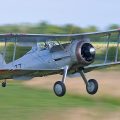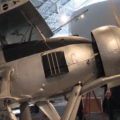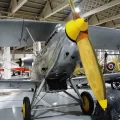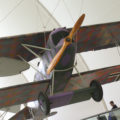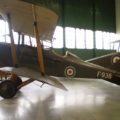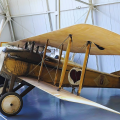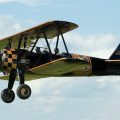
Sopwith 1½ Strutter | |
|---|---|
| Land | Großbritannien |
| Rolle | Doppeldecker-Allzweckflugzeug |
| Erstflug | Dezember 1915 |
| Gebaut | 4500 Frankreich & 1439 Großbritannien |
das Sopwith 1+1⁄2 Strutter war ein britisches ein- oder zweisitziges Mehrzweck-Doppeldeckerflugzeug des Ersten Weltkriegs. Es war der erste britische zweisitzige Traktorjäger und das erste britische Flugzeug, das mit einem synchronisierten Maschinengewehr in Dienst stellte. Es erhielt den Namen 1 + 1⁄2 Strutter wegen der langen und kurzen Cabane-Streben, die den oberen Flügel stützten. Der Typ wurde von beiden britischen Flugdiensten betrieben und war im weit verbreiteten, aber glanzlosen Dienst bei der französischen Aéronautique Militaire.
| Sopwith 1A2 Strutter Walk Around | |
|---|---|
| Fotograf | Unbekannter |
| Lokalisierung | Unbekannter |
| Fotos | 21 |
Zugehörige Kits:
Finden Sie Kits bei eBay:
The Sopwith 1½ Strutter was a versatile and innovative biplane aircraft that served in various roles during the First World War. It was designed by the Sopwith Aviation Company in England, and was powered by a rotary engine that gave it a top speed of about 100 mph (160 km/h). The name 1½ Strutter came from the distinctive arrangement of the wing struts, which consisted of a pair of short struts near the fuselage and a pair of longer struts farther out, forming a W shape when viewed from the front.
The 1½ Strutter was the first British aircraft to have a synchronised machine gun, which allowed the pilot to fire through the propeller without damaging it. This gave it an advantage over the German fighters that relied on interrupter gears or deflector plates. The 1½ Strutter also had a variable-incidence tailplane that could be adjusted in flight to balance different loads, and air brakes that reduced the landing distance. The aircraft had a long range and endurance, making it suitable for reconnaissance, bombing, and escort missions.
The 1½ Strutter entered service with the Royal Naval Air Service (RNAS) and the Royal Flying Corps (RFC) in 1916, and was also used by several other countries, including France, Belgium, Russia, and Japan. It was produced by Sopwith and several other contractors, with a total of about 5,939 built. The 1½ Strutter proved to be reliable and effective in combat, but was gradually replaced by newer and faster aircraft as the war progressed. It remained in service until 1919, and some were used for civilian purposes after the war.
Ansichten : 789

